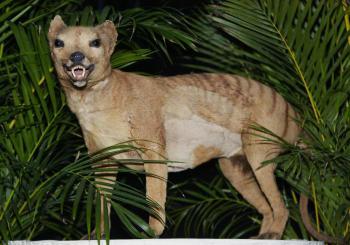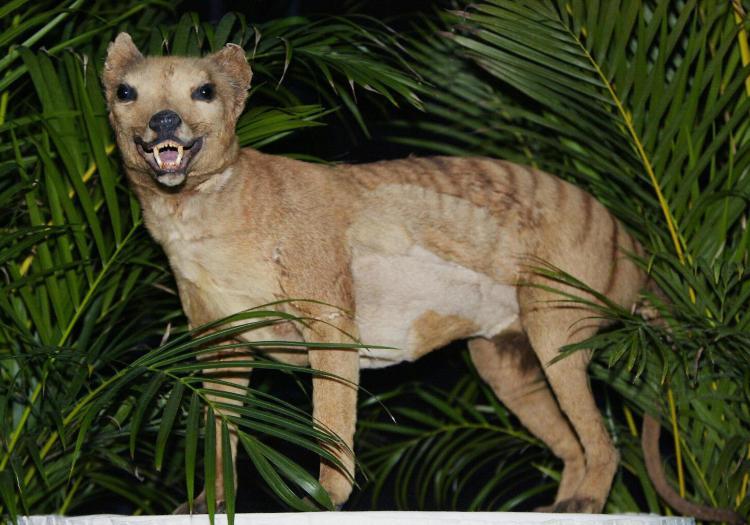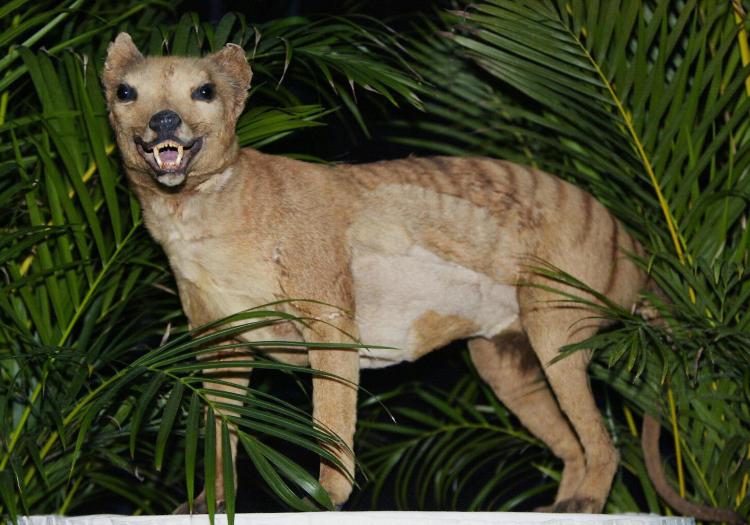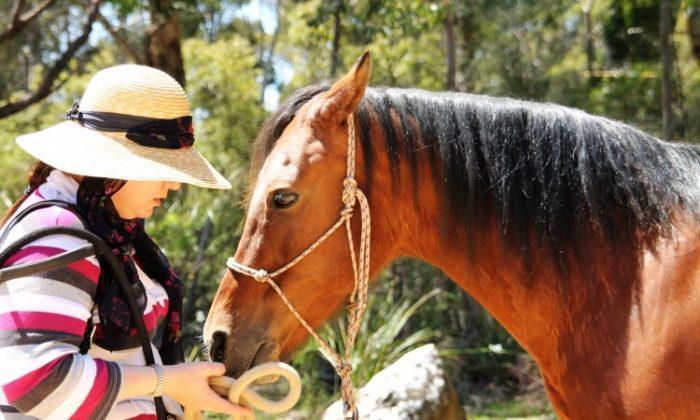The Tasmanian tiger lives in dry eucalypt forest, wetlands and grasslands in Tasmania. From indigenous fossil paintings, we can determine that it also lived in Papua New Guinea and mainland Australia. Some remains discovered date back to 2,200 years ago. It is generally believed that the Wild Dog or Dingo contributed to its extinction in these two places. The Bass Strait, however, protected this population of thylacines in Tasmania giving it an opportunity to thrive for thousands of years, until the Europeans arrived.
The ‘Tassie Tiger’ may appear something like a dog, but unlike other canines, it carries its young in a pouch, similar to a kangaroo, except the pouch opens from the back. The mother can carry a litter of up to three young in her pouch. It keeps extending and accommodating them as they grow, until it stretches and almost touches the ground. For a lair, they live together in a deep rocky cave, from where the mother goes off to hunt in the evenings, through the night, returning home at dawn. The Tasmanian tiger has remarkable stamina, along with an acute sense of smell, and pursues its prey until it simply collapses from exhaustion.
This unique marsupial also has a thick, strong tail like a kangaroo. The dark brown/black stripes across its back, ending at its side gives this animal its tiger name, and it can open its jaw wide up to 120 degrees. The Tasmanian tiger feeds mainly on small mammals, wallabies, kangaroo, rats and mice. It stands 2 ft tall, is 6 ft from nose to tail and weighs in at approximately 30kg.
The Tasmanian Tigers thrived in their thousands until the 1830s when the government called on a bounty because the carnivores were a threat to livestock, killing many sheep in Tasmania. There was another bounty hunt in 1888 that saw many more slaughtered, leading to dangerously low numbers. It wasn’t until 1936 that the Tasmanian tiger was added to the list of protected wildlife. In 1986, it was declared extinct by international standards.
Since Europeans arrived in Australia, the Tasmanian Tiger has been the only mammal to have been wiped out in Tasmania. On the mainland, however, nearly 50% of native animals species have been made extinct—the worst record of extinctions out of any country in the world.
There have been no successes of Tasmanian Tigers in captivity reproducing. In fact, when in captivity, this animal was extremely nervous and often seemed to die from shock. In the wild, they are very shy of humans and avoided contact. ‘Benjamin’ the last surviving Tasmanian tiger lived his final days in the Hobart Zoo, Tasmania, and died 60 years ago. Many local Tasmanians beg to differ on this fact though, because numerous sporadic and unconfirmed sightings have been reported around the forests near their old habitat in the Northern regions to this day. A study of sightings by Steven Smith between 1934 and 1980 analysed the authenticity of as many as 320 reported sightings by local residents. Smith concluded that as many as half of the sightings were good and could have possibly been the real thing.
The government, along with biologists and photographers, has made many expeditions into the wild areas of North Tasmania to collect evidence that the Tiger may still be in existence. But these many investigations in the 1930s through to the 1980s were fruitless. However, the reported sightings continue, although government departments may no longer be taking such reports seriously.
Imagining that the species was not extinct, biologists have doubts about its capability of reproducing for an extended period of time because there are not enough numbers in the wild to sustain genetic diversity for a perpetuated existence. But, the question is, how long after a last verifiable sighting can we then declare a species extinct? Should the Australian Sanctuary Law be revoked to protect it? Just supposing it still exists out there—it could truly be the rarest animal in the world.
CAVEAT: This article was originally published on the Epoch Times website on Mar 16, 2006. The information contained herein may no longer be current.







Friends Read Free